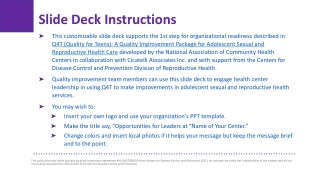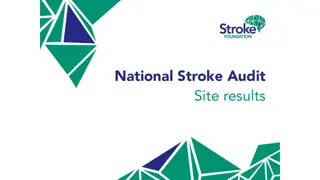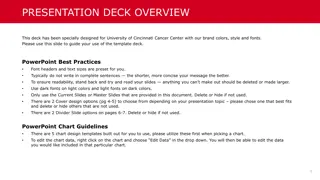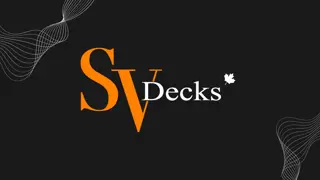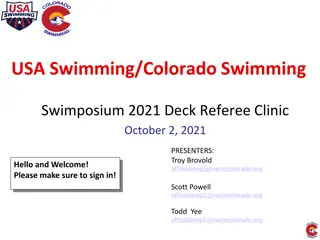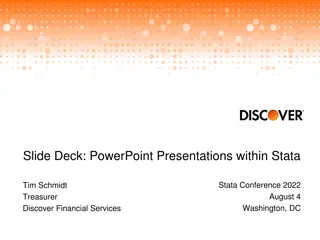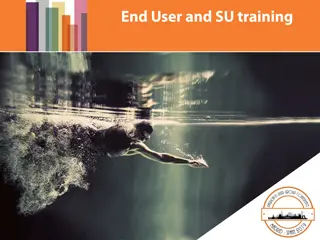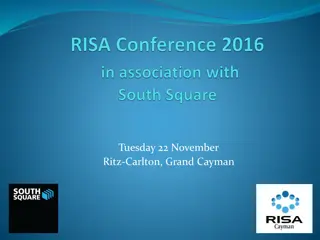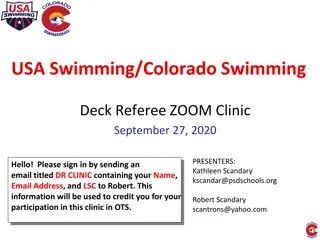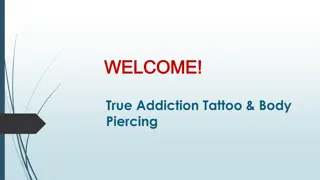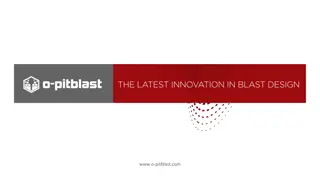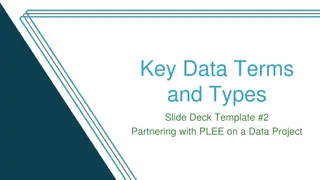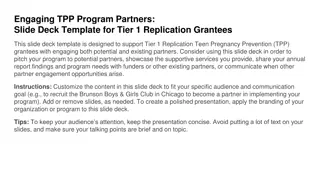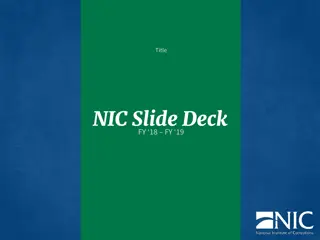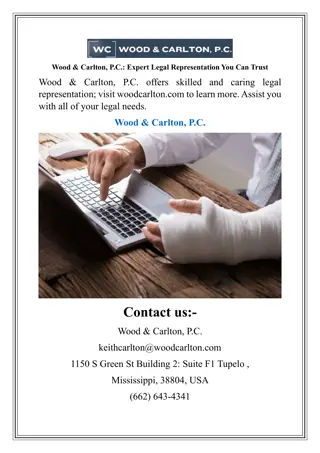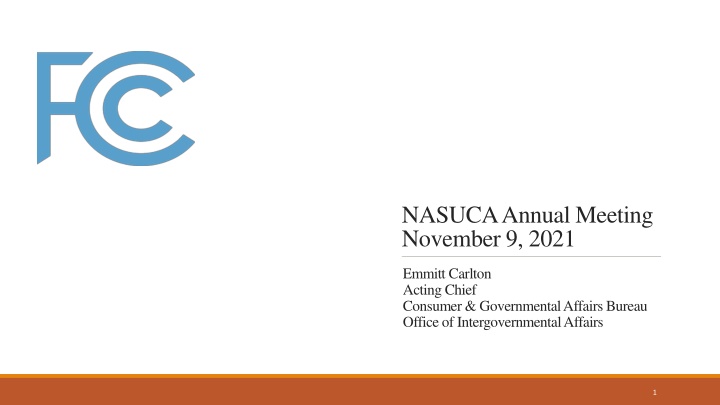
FCC's Consumer and Governmental Affairs Bureau (CGB) and Office of Intergovernmental Affairs (IGA)
Explore the functions of the FCC's Consumer and Governmental Affairs Bureau, including divisions and offices focusing on consumer issues and governmental affairs. Learn about the Office of Intergovernmental Affairs, its role, and responsibilities in fostering understanding of FCC programs and policies among state and local governments.
Download Presentation

Please find below an Image/Link to download the presentation.
The content on the website is provided AS IS for your information and personal use only. It may not be sold, licensed, or shared on other websites without obtaining consent from the author. If you encounter any issues during the download, it is possible that the publisher has removed the file from their server.
You are allowed to download the files provided on this website for personal or commercial use, subject to the condition that they are used lawfully. All files are the property of their respective owners.
The content on the website is provided AS IS for your information and personal use only. It may not be sold, licensed, or shared on other websites without obtaining consent from the author.
E N D
Presentation Transcript
NASUCA Annual Meeting November 9, 2021 Emmitt Carlton Acting Chief Consumer & Governmental Affairs Bureau Office of Intergovernmental Affairs 1
Outline Overview of CGB, IGA and IAC Emergency Connectivity Fund Emergency Broadband Benefit Program 2
FCCs CONSUMER AND GOVERNMENTAL AFFAIRS BUREAU (CGB) 10 Divisions and Offices Main focuses are (i) consumer policy, information, outreach & complaints, disabilities access and (ii) governmental affairs Consumer Issues: Consumer Policy Division (CPD) Consumer Affairs and Outreach Division (CAOD) Consumer Inquiries and Complaints Division (CICD) Disabilities Rights Office (DRO) Governmental Affairs: Office of Intergovernmental Affairs (IGA) Office of Native Affairs and Policy (ONAP) 3
OFFICE OF INTERGOVERNMENTAL AFFAIRS The Office of Intergovernmental Affairs, established in 2004, was created during an FCC re-organization to establish a primary point of contact and face of the FCC for state and local governments and their organizations IGA staff each have responsibilities for outreach to state and local government organizations such as NATOA, National League of Cities, National Association of Counties 5
IGA ORGANIZATIONAL CHART Consumer and Governmental Affairs Bureau Patrick Webre, Chief Barbara Esbin, Deputy Chief IGA Emmitt Carlton, Acting Chief and Deputy Chief Theodore Marcus, Associate Chief Barbara Britt Yvette Cage Kamala Hart Michelle Jones Outreach Advisors Donna Cyrus Gayle Teicher Aliza Katz Senior Legal Advisors 6
IGAs MISSION IGA is the portal in for receiving and processing questions and referrals from state and local governments If IGA can t answer questions directly, it finds FCC subject matter experts who can IGA is the portal out providing information and outreach to state and local governments, as well as other federal regulatory agencies, for the purpose of fostering an understanding of FCC programs, policies, rules and decisions Regularly attending and participating in conferences, seminars and industry meetings Issuing informational blasts and webpage Spotlights IGA oversees the work and activities of the Intergovernmental Advisory Committee (IAC), and ad hoc special projects like the Hospital Robocall Protection Group 7
INTERGOVERNMENTAL ADVISORY COMMITTEE The IAC is a non-FACA advisory committee created by the FCC and governed by the Unfunded Mandates Reform Act. Pursuant to UMRA, IAC meetings and communications with FCC staff are non-public to encourage candid exchanges. The IAC advises the FCC on communications issues affecting state and local governments that are within the jurisdiction of the FCC and may be called upon to provide guidance on specific topics the Commission deems necessary to address matters before it. Rules governing IAC s operations are found at 47 CFR 0.701, which specify a minimum number of members from various categories to ensure proportional representation of state, local, municipal and Tribal governments, including executive and legislative levels. The previous IAC submitted reports to the Commission on topics such as multilingual emergency alerting, state participation in state emergency communications committees (SECCS), intergovernmental disaster response coordination and state, local Tribal, and territorial barriers and incentives to telemedicine. 8
Overview The $7.171 billion Emergency Connectivity Fund was created as part of the American Rescue Plan Act of 2021. Support is distributed to eligible schools and libraries to purchase eligible equipment and/or services for use by students, school staff, and library patrons with unmet needs at locations other than a school or library, during the COVID-19 emergency period. Applicants may seek funding for (i) up to $400 for each connected device (laptops and tablets); and (ii) up to $250 for each Wi-Fi hotspot provided to a student, school staff or library patron. 10
ECF Award Activity The FCC and the program administrator, USAC, opened two windows for schools and libraries to apply for the ECF Program. During the first application filing window (June 29 to August 13, 2021),the program received requests for $5.137 billion. During the second application filing window (September 28 to October 13, 2021), the program received requests for nearly $1.3 billion. As of October 25, 2021, the Commission has committed $2.63 billion in program funding to school and library applicants. With the first three waves, the FCC is providing support for over 6.1 million connected devices and nearly 2.9 million broadband connections to support 6,028 schools, 512 libraries, and 49 consortia. 11
Eligible Entities Eligible Entities include: Schools, libraries, and consortia of schools and libraries that are eligible for support under the E-Rate Program. o Elementary and secondary schools as defined by states under the Elementary and Secondary Education Act (ESEA). For-profit schools are not eligible for support Schools with an endowment of $50 million or more are not eligible. 12
Eligible Entities (contd) Libraries eligible for support under Library Services and Technology Act (LSTA). o Tribal libraries are eligible for support under LSTA and are therefore eligible for Emergency Connectivity Fund Program support. Schools and libraries do not need to be participants in the E-Rate Program to participate in the Emergency Connectivity Fund. o Eligibility will be verified during the application review process. 13
Eligible Equipment and Services Eligible equipment includes: Connected devices (laptop computers and tablet computers) Desktop computers and smartphones are not eligible for funding. Wi-Fi hotspots Modems (including aircards) Routers Devices that combine a modem and router 14
Eligible Equipment and Services (contd) Eligible services include: Commercially available fixed or mobile broadband Internet access services Dark fiber is ineligible for support. Construction of broadband networks and customer premises equipment for receiving datacasting services are also ineligible, except in the limited case where there is no commercially available Internet access service sufficient for students, school staff and library patrons to engage in remote learning. 15
ECF Program Resources For additional information on the ECF Program, please visit: https://www.emergencyconnectivityfund.org/ For the most Frequently Asked Questions about the ECF Program, please visit: https://www.fcc.gov/emergency-connectivity-fund-faqs For all other ECF-related inquiries, you can contact the Emergency Connectivity Fund Customer Support Center at (800) 234- 9781, Monday through Friday, 8 a.m. to 8 p.m. E.T. 16
What Is The Emergency Broadband Benefit Program? The Emergency Broadband Benefit Program is a Federal Communications Commission (FCC) program that provides a temporary discount on monthly broadband bills for qualifying low-income households. Under the present EBB, eligible households can receive: Up to $50/month discount for broadband service and associated equipment rentals; Up to $75/month discount for households on Tribal lands; and A one-time discount of up to $100 for a laptop, desktop computer, or tablet purchased through a participating provider. The infrastructure bill currently being debated in Congress would make the EBB permanent, increase its appropriation (from $3.1 billion to $14 billion), and rename it the Affordable Connectivity Program, among other proposed changes. 18
EBB Enrollment Activity Since the EBB s inception in May 2021, over seven million low-income households have enrolled in the EBB, and over 1200 broadband providers have chosen to take part in the program. As of October 31, 2021, of the $3.136 billion in funding appropriated for EBB, roughly $859 million in total support has been claimed, leaving roughly $2.3 billion available for disbursement. https://www.usac.org/about/emergency-broadband-benefit-program/emergency- broadband-benefit-program-enrollments-and-claims-tracker/ 19
Who Qualifies for the Benefit? A household is eligible if any member: Received a Pell Grant in the current award year; Is approved to receive benefits under the free and reduced school lunch program or school breakfast program in the 2019-2020, 2020-2021, or 2021-2022 school year; Experienced a substantial loss of income, due to a job loss or furlough since 2/29/20 and the household had a total income in 2020 below $99,000 (single filers) or $198,000 (joint filers); or Meets the eligibility criteria for a participating provider s existing low- income or COVID-19 program. 20
Who Qualifies for the Benefit? (contd) A household is eligible if any member qualifies for Lifeline Household income is less than 135% of the Federal poverty guidelines or A member of the household participates in one of these programs: Supplemental Nutrition Assistance Program (SNAP), formerly known as Food Stamps Medicaid Supplemental Security Income (SSI) Federal Public Housing Assistance (FPHA) Veterans Pension and Survivors Benefit Certain Tribal programs (and the household lives on qualifying Tribal lands) 21
How to Enroll There are three ways to apply for the Emergency Broadband Benefit Option 1: A consumer can contact a participating broadband provider directly to learn about their application process. Option 2: Go to GetEmergencyBroadband.org to apply online and to find participating providers through the Companies Near Me tool. Option 3: Send a mail-in application, along with proof of eligibility to the Emergency Broadband Support Center. 22
EBB Program Resources FCC EBB Program Information (Answers to FAQs, become an outreach partner) https://www.fcc.gov/broadbandbenefit FCC EBB Program Outreach Toolkit (flyers, PSAs, social media content in multiple languages) https://www.fcc.gov/emergency-broadband-benefit-outreach-toolkit USAC EBB Program Consumer Webpage (Program and provider info; application) https://www.getemergencybroadband.org Enrollment https://www.usac.org/about/emergency-broadband-benefit-program/emergency-broadband- benefit-program-enrollments-and-claims-tracker/ and Claims Tracker (enrollment data by ZIP code available) 23
FOR MORE INFORMATION Barbara Esbin, Deputy Bureau Chief, Consumer & Governmental Affairs Bureau, Barbara.Esbin@fcc.gov Emmitt Carlton, Acting Chief and Deputy Chief, Office of Intergovernmental Affairs and Policy, Emmitt.Carlton@fcc.gov Theodore Marcus, Associate Chief, Office of Intergovernmental Affairs, Theodore.Marcus@fcc.gov https://www.fcc.gov/general/consumer-and-governmental-affairs-bureau https://fcc.gov/consumer-and-governmental-affairs/office-intergovernmental-affairs https://www.fcc.gov/about-fcc/advisory-committees/general/intergovernmental-advisory-committee 24

